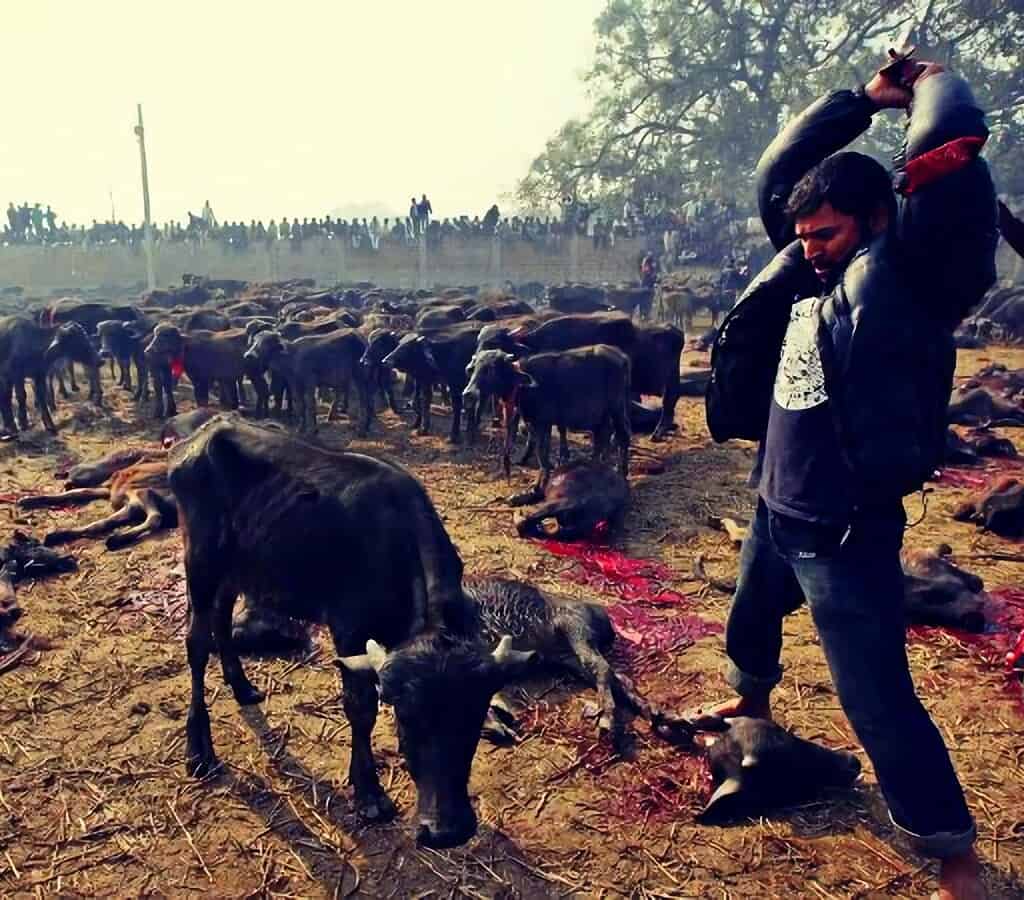Discover the dark side of the Gadhimai Festival, where thousands of animals are sacrificed in the name of tradition. Why does this controversial ritual continue in the 21st century? Keep reading to uncover the secrets and history behind this festival that divides opinions.
History and Significance of the Gadhimai Festival
Origins of the Festival
The Gadhimai Festival has deep roots in Nepal’s history. It is said to have started over 260 years ago when Bhagwan Chaudhary, a local landowner, had a dream in which the goddess Gadhimai asked him to build a temple in her honor. In gratitude for the goddess’s help, Bhagwan sacrificed animals, thus establishing the tradition that continues today.
Devotion and Pilgrimage
Every five years, millions of pilgrims from Nepal and India travel to Bariyarpur to participate in the festival. The Nepalese pilgrimage is an act of extreme devotion, where the faithful believe that animal sacrifice to the goddess Gadhimai will bring them prosperity, protection and the fulfillment of their desires. This sacrificial ritual includes not only the slaughter of animals but also purification ceremonies, chanting and dancing.
Controversy of the Gadhimai Festival
Animal Sacrifice: A Cruel Practice
The most controversial aspect of the festival is undoubtedly the animal sacrifice in Nepal. During the event, thousands of buffaloes, goats, pigs, rats and birds are sacrificed in a collective act that many consider to be an extreme display of cruelty. Images of rivers of blood and decapitated animals have provoked international outrage, prompting organizations like Animal Equality to document and denounce these acts.
Animal Rights and Protests
Animal rights organizations have vehemently condemned the festival, arguing that animal sacrifice is inhumane and has no place in modern society. Global campaigns have been launched to stop the festival and in 2015, the Gadhimai Temple announced that there would be no more sacrifices. However, despite this announcement, the 2019 festival proceeded with sacrifices, demonstrating the difficulty of changing deeply rooted traditions.
Economic Impact of the Gadhimai Festival
Benefits for the Local Community
The economic impact of the Gadhimai Festival cannot be underestimated. During the event, the influx of pilgrims generates significant income for the region. Local vendors, hoteliers and transporters greatly benefit from the festival, creating a strong economic incentive to maintain the tradition.
Costs and Controversies
However, the festival also involves significant costs, both economic and ethical. The Nepalese government has had to manage international criticism and public health issues arising from the mass slaughter of animals. Additionally, the pressure to modernize and civilize traditional practices faces resistance from local communities that economically depend on the festival.
Symbolic Manifestation and Devotion
Spiritual Significance
For the devotees, the Gadhimai Festival is much more than a cultural event; it is a symbolic manifestation of their faith and devotion. The sacrifices are seen as offerings to the goddess, an act of gratitude and a means to secure her favor. This spiritual dimension is crucial to understanding why, despite the criticism, the festival remains a vital part of the religious life in the region.
Resilience of Tradition
The resilience of the Gadhimai Festival tradition is remarkable. Despite campaigns against it and attempts to ban it, the local community remains committed to its ancestral practices. This resistance highlights the conflict between preserving cultural traditions and adopting new global ethical standards.
Future of the Gadhimai Festival
Moves Towards Modernization
There are signs of change on the horizon. The temple authorities and the Nepalese government have shown a willingness to discuss possible reforms that could modernize the festival without eliminating its cultural essence. Alternatives to animal sacrifice, such as symbolic offerings and non-violent rituals, are being considered to maintain devotion without cruelty.
The Role of Education and Awareness
Education and awareness play a crucial role in this process of change. Awareness campaigns about animal rights and the promotion of ethical alternatives can help transform the festival into a celebration that honors both the goddess Gadhimai and modern values of compassion and humanity.
Devotion in the Gadhimai Festival
Sacrificial Ritual
The sacrificial ritual is the heart of the festival. Devotees believe that by offering an animal to the goddess Gadhimai, they are performing an act of deep devotion that will be rewarded with good fortune and divine protection. Although many view this practice as archaic and brutal, participants see it as an expression of faith and a way to connect with their ancestors and traditions.
Symbolic Manifestation
The symbolic manifestation of this festival goes beyond the physical act of sacrifice. It represents the struggle between the old and the new, tradition and change. Each sacrifice is a reminder of the rich and complicated history of Nepal and India and how religious and cultural beliefs can influence social practices.
Controversy and Animal Rights
International Debate
The Gadhimai Festival has captured international attention, sparking intense debate over animal rights and the ethics of ritual sacrifice. Animal rights organizations argue that the suffering inflicted on animals is unnecessary and cruel and that traditions must evolve to reflect greater compassion and respect for all forms of life.
Local Community Response
The local community, however, defends the festival as an integral part of their cultural and religious identity. For many, the sacrifices are a way to honor the goddess Gadhimai and keep an ancestral tradition alive. This conflict between external and internal perspectives highlights the complexity of changing practices that are deeply rooted in a community’s history and culture.
Future Perspectives
Potential Reforms
Although the path to change is challenging, there are signs that it is possible. Temple authorities have expressed interest in finding ways to modernize the festival without losing its spiritual significance. This could include implementing less violent practices or replacing animal sacrifices with symbolic offerings.
Education and Awareness
Education and awareness are key to change. As more people become informed about animal rights and ethical alternatives to sacrifice, it is possible that social pressure and global awareness will drive a transformation in the festival’s practices. Collaboration between activists, religious authorities and the community can pave the way for a festival that celebrates devotion and tradition without the need for violence.
Conclusion: Preserving Ancestral Traditions
The controversy surrounding the Gadhimai Festival reflects the struggle between preserving traditions and adapting to new ethical standards. As awareness of animal rights grows, there is hope for a future where the festival can be celebrated without violence, honoring both the goddess Gadhimai and promoting respect for life.




